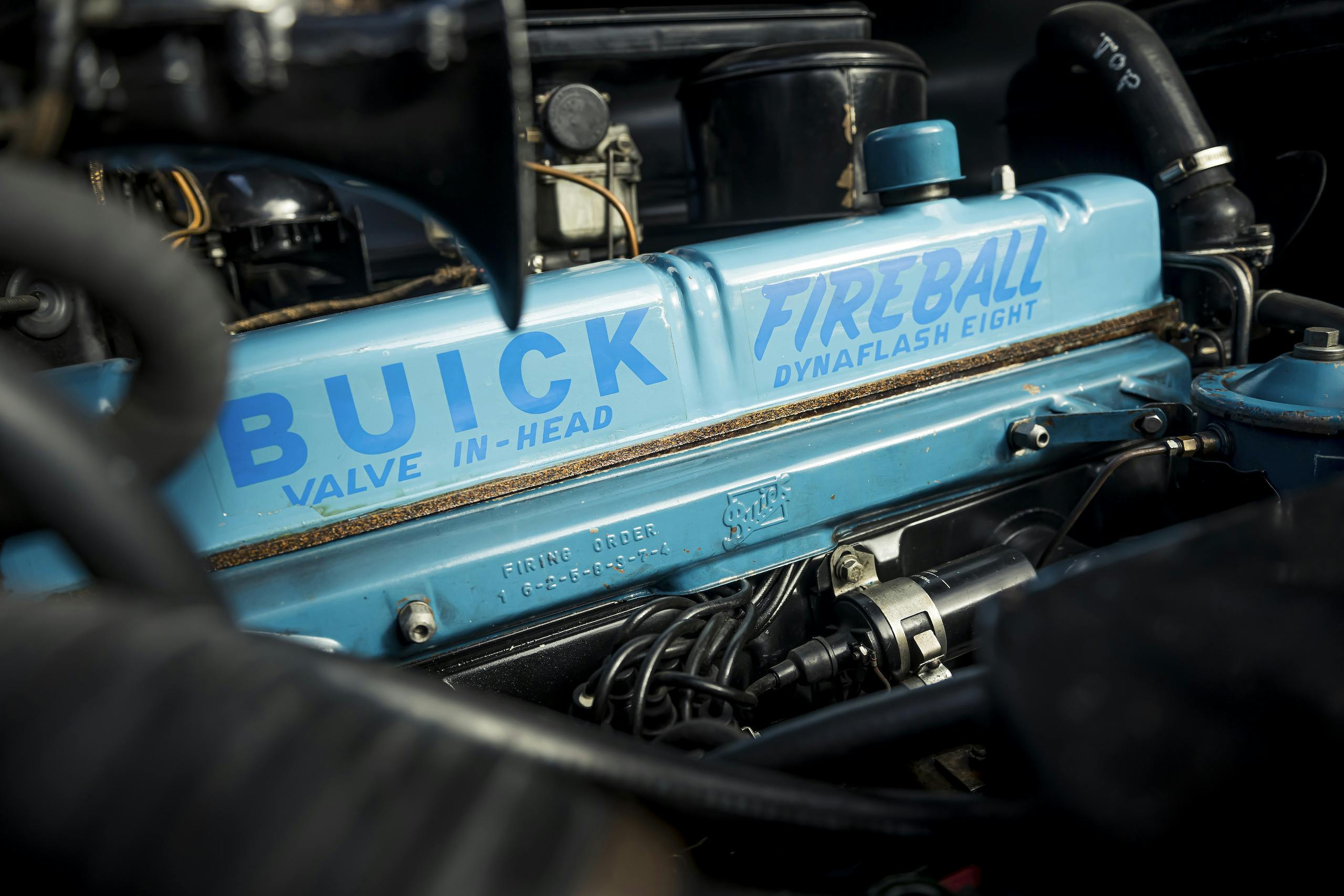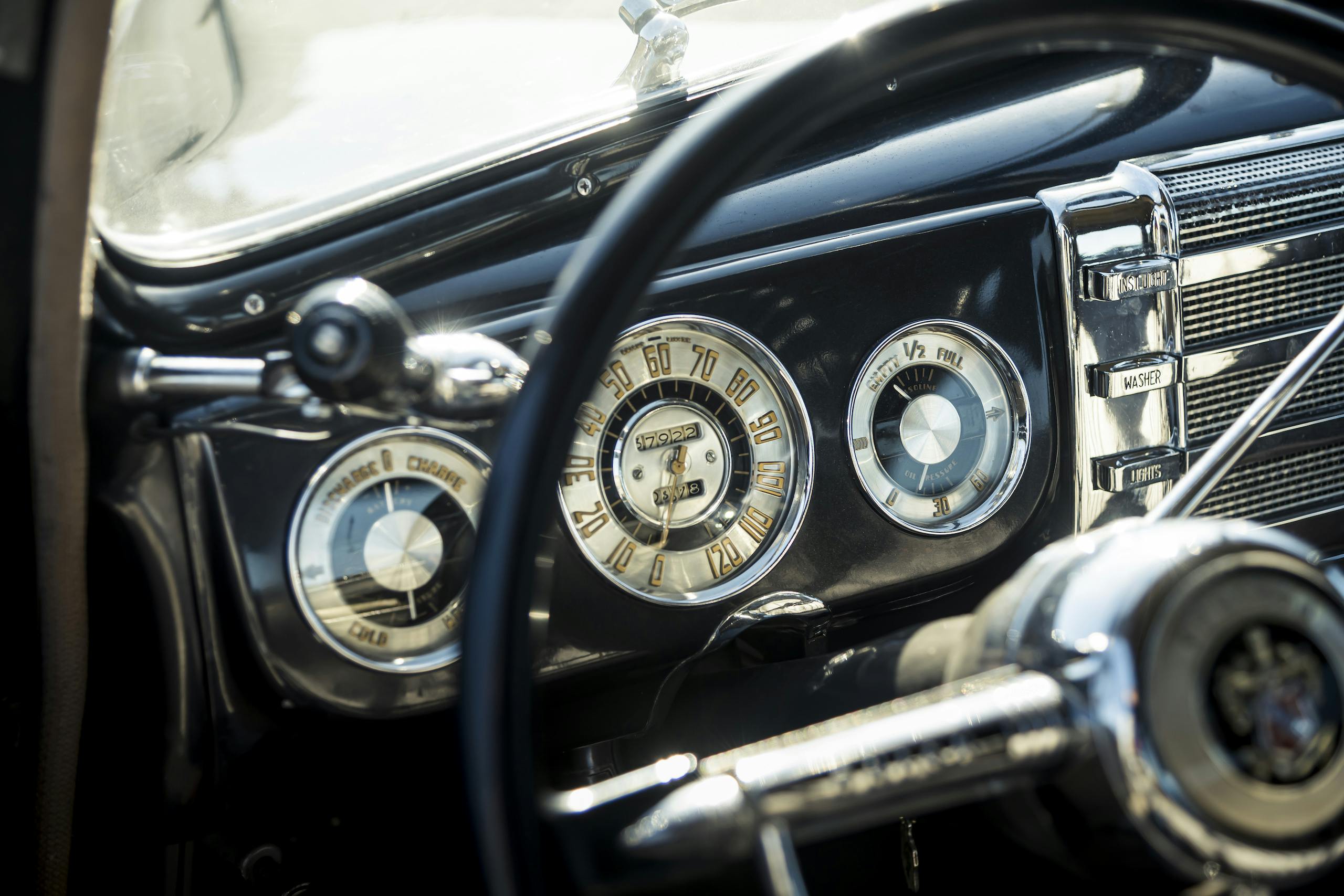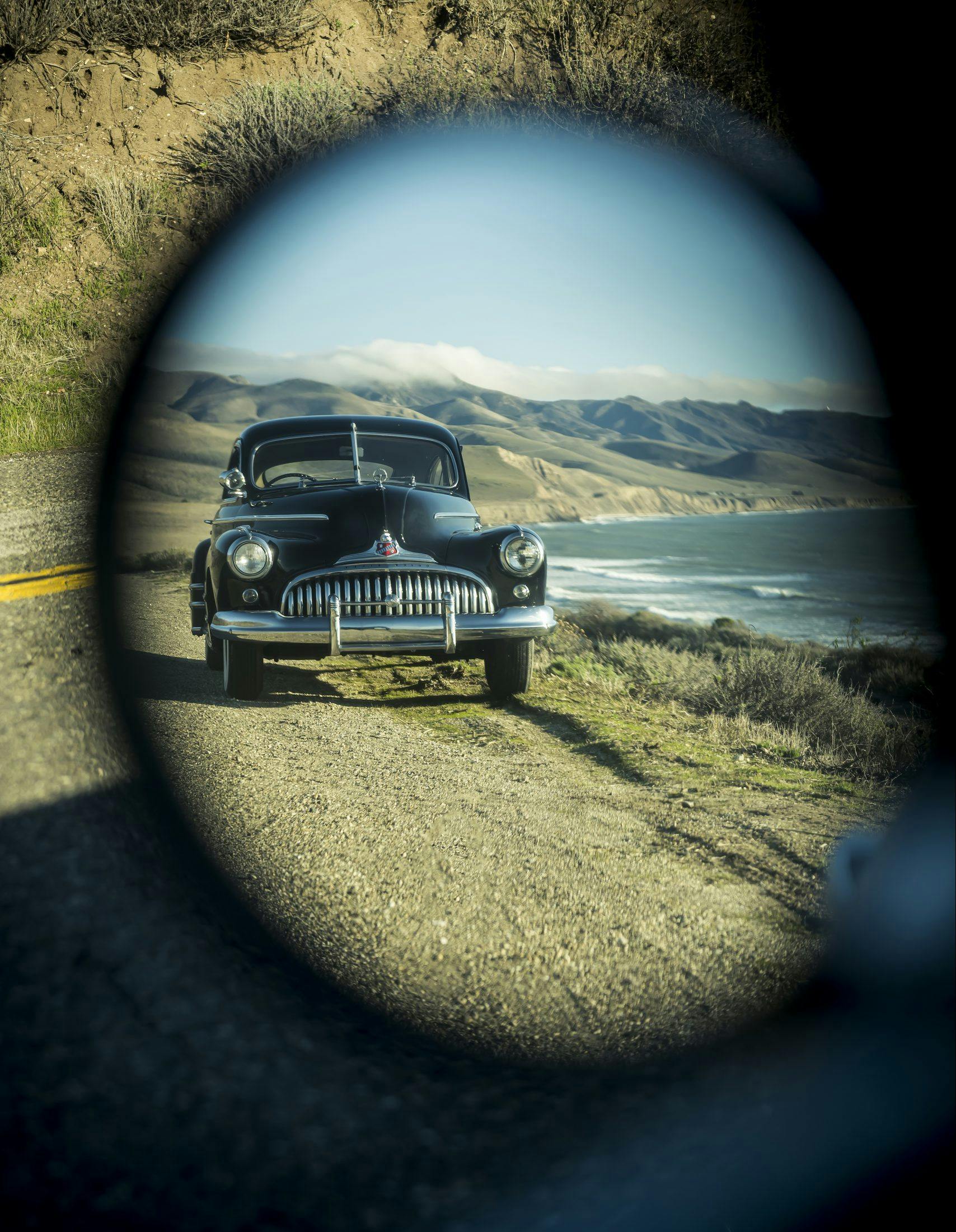Two Speed Cruise: ’49 Buick and ’69 Porsche in the battle of fast vs. slow
The 1949 Buick Special and the 1969 Porsche 911 weren’t marketplace competitors. They weren’t really designed to appeal to the same people, and you don’t often find them in the same collections. In fact, they seem to come from entirely different planets, so much so that it’s hard to believe that the Buick was just a 20-year-old used car when the Porsche was new, as common on the roads then as a 2001 Buick Regal might be today.
No doubt you’re dying to know why we threw them in a story together. It started (as it often does) with a debate among coworkers. One side: Our boss, Larry Webster, he of the 911 owners club, took the position that it’s more fun to drive swiftly on a road trip, to pleasure in the delights of a well-cut apex and an expertly executed downshift while speeding along excellent, undulating roads at the helm of a precision-engineered machine.
The other side (your author, he of the somewhat-grayer Buick owners club) stated that a road journey is about more than driving, that it’s about experiencing what the route has to offer along the way, about reading the signs and smelling the air and listening to the sounds of the country. All of which is impossible if the landscape is whisking past you as you laser-focus on the next hairpin. The two sides were intractable. Larry insisted that the whole point of automotive evolution was to achieve speed with comfort and safety; that speed equals time, the most precious and irreplaceable commodity of them all, and thus speed is a pure good. Especially when wrapped in the right package, such as a vintage Porsche.
I, on the other hand, argued that all you can see at speed is blur and smashed bugs. “The world has gotten to be in too much of a hurry,” I told Larry during a Zoom call last fall. So we put our cars where our mouths were and convened in Southern California in February for a tour of the middle coastal counties, where the surf laps onto lonely beaches and where pinot and grenache and syrah grapes grow in neatly combed rows on the slopes of the green and brown hills.

GM’s famous styling chief, Harley Earl, is said to have told his design team in 1938 as they were tasked with developing a dream car of the future, “I just want a little semi-sports car, a kind of convertible.” They called it the Y Project, a play on the “X” designation that aircraft makers used for their experimental machines, but Earle kept referring to it as “that Y job,” and the name stuck. Long and wide, the Y-Job did indeed look futuristic compared with the contemporary cars of the era with their coffin noses, cycle fenders, and running boards. It melded the broad, triangular hood and fenders together into one sculpted form, ditched the vertical grilles then fashionable for a broad, low mouth slatted with chrome bars, shed the running boards, adorned the elongated fenders with art-deco streamer lines, and closed its hole through the air with an alluringly tapered fastback tail.
Those styling concepts went into production as the dramatically redesigned 1942 Buicks featuring “Airfoil” fenders, the “Weather Warden Venti Heater” cabin airflow system, and the “Fireball” valve-in-head straight-eight. Buick unveiled its new wares exactly 35 days before the attack on Pearl Harbor. The machine tools and stamping dies for the ’42 Buicks went into storage to await the peace.
When it came, Buick’s shrewd manager, Harlow Curtice, figured that pent-up postwar demand for new cars was close to 9 million units and that Buick would need to churn out a half-million cars per year in the immediate postwar period to maintain its prewar market share. However, persistent shortages of raw materials, as well as labor unrest, prevented Buick from achieving that lofty number, so it leaned its production toward its more profitable Super and Roadmaster lines. The lowly Special, so important to Buick’s sales in the Depression, was barely mentioned in company literature.
By late 1948, when a Mrs. Odessa Hensley walked into Woods & Vandivier Motor Sales in Franklin, Indiana, to pick up her new black 1949 Buick Model 46S Special sedanet, the postwar rush had tapered off. Hensley’s ’49 Special, the car pictured here, was a remnant, one of roughly 4000 body shells Buick had remaining of the older ’48 Specials that didn’t fit with the ’49 Supers and Roadmasters, with their freshened horizontal lines and new fender portals. Buick slammed these few remaining Specials through the plant between September and December 1948, called them ’49s, then shut down Special production for the rest of the year to make way for a grand relaunch of its entry-level model in 1950.
Thus, notwithstanding the new grille and small trim changes worked in by Buick’s postwar styling chief, Ned Nickles, the 1949 Buick I’m driving is effectively one of the last 1942 Buicks the company ever produced and the last direct descendant of the Y-Job. It was outdated even as it sat new in the showroom as Buick’s cheapest and smallest car for 1949; it also bore the dubious reputation of being the choice of widows and preachers (indeed, Hensley was a widow, her husband having died in 1931). Still, it’s hard to gaze upon the lines of this fastback Buick today and think of it as being dowdy in any way.

In fact, when the Buick is sitting next to a 1969 Porsche 911, there seems to be almost a family resemblance in the way its roof curves in one clean line down to the tail, and the side glass echoes the shape. As it happened, we had three examples of Porsche’s beloved project 901 along on our trip, including two four-cylinder 912s owned by our photographer, James Lipman, and our Hagerty cohort Logan Calkins. The Buick leading those three Porsches up State Route 154 into the hills behind Santa Barbara looked like a mama turtle at the head of a junior turtle parade.
It’s hard to imagine that the comparatively Lilliputian 911, from its earliest fetal moments as mere line drawings and sketches, was known inside the company as “the big Porsche.” But company founder Ferdinand Porsche was acutely aware that chief among the complaints of customers abandoning their 356s for other vehicles was the car’s lack of interior space. “You can’t even get a set of golf clubs in the 356,” he’s said to have grumped, and the car was not easy to get in and out of because of the rearward position of the A-pillar and door hinges.
Page through Karl Ludvigsen’s seminal four-volume Porsche history, Excellence was Expected, and you’ll see old black-and-white studio photos of the design concepts that grew out of those complaints. They show how tantalizingly close Porsche came, as early as 1959, to the final perfection that would be the 911. But originally, the proposal mandated four full seats, which would have meant a 911 with a longer, flatter roof and what might be uncharitably called a full diaper. A parallel design project to create a cheaper, 356-based two-seater to sell alongside this “large” Porsche actually got right the rear-end shape, and forces within Porsche began to push for that design to be the one product Porsche would deploy to replace the 356.
However, according to Ludvigsen, it wasn’t design factors that determined Ferdinand’s final decision to drop the larger four-seat concept in favor of the shapelier 911 that we all know and love. It was the war (again) and the Allies’ rationalizing of Germany’s postwar car industry—in which Volkswagen would build the cheap cars, Mercedes-Benz the expensive cars, Ford and Opel the middle-class vehicles, and Porsche the sports cars (with BMW, NSU, etc., only factoring in as niche oddballs). Ferdinand was as yet unwilling to upset the scheme by encroaching on a market belonging to others, a factor that obviously plays no part in today’s world of Porsche sedans and SUVs. So he stuck with his sports car project and the 911 debuted in 1964 to immediate raves.
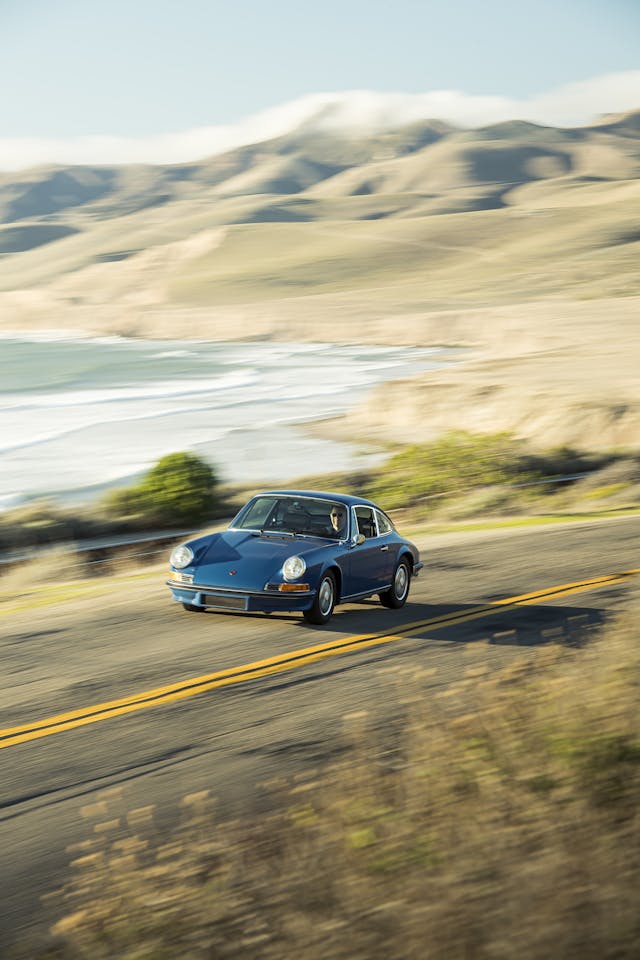
A few years ago, our man Larry Webster hauled his ’69 911E out of a rural Michigan barn, where it had been slumbering for 30 years. The E stands for Einspritzung, denoting the Bosch mechanical fuel-injection system that Porsche put on this deluxe version of the 911 from 1969 to 1973. Larry overhauled the 2.0-liter flat-six, replaced a suspension that was tired after 95,000 miles on Midwest roads, and added Recaro seats. The rest, including its original Ossi Blue paint job and 14-inch Fuchs wheels, he left as found.
Porsche thought its 911 improved on the 356 by being bigger. Today, getting in one feels like pulling on a perfectly tailored wetsuit. Prices of these early 911s have gone kablooey precisely because they are just so right; so immediate in their responses, so comfortable over a journey, so easy to see out of, so clearly built to last, and so lovely to look at. It is a masterwork of industrial art.
Though it’s roughly the same shape, the Buick is enormous, rather leisurely to answer its helm or throttle, comfortable over a long journey only if you are traveling not in the hot season and don’t have preexisting lower back problems, and difficult to see out of. There’s a reason why drives over a hundred miles used to take two days; why Grandpa needed a Lucky Strike and a lie-down after wrestling all day with bias-ply tires, a column shifter, and drum brakes, all while dressed in gabardine and braces. But the Buick, too, is a work of industrial art that never fails to draw waves and a thumbs-up as it glides by.

After a night at a ranch up in the hollows of the Santa Ynez hills, we were awakened by the incessant gobbling of wild turkeys. We spent the morning making breakfast, listening to the turkeys (who, we were soon to discover, were crapping on our cars), and watching the chilly winter sun slowly chase the shadows from the hills. Heading out on the road, our convoy passed first through Solvang, a re-created Danish village that is the region’s reigning tourist magnet, past an ostrich farm, and into the old Coast Highway service town of Buellton, home of Pea Soup Andersen’s, an immense Tudor-style eatery with half-timbered walls and steeply sloped roofs.
Anton Andersen departed Denmark for central California in 1924 with his French wife Juliette and their son Robert, intent on following his brother, who was already settled in Solvang. The Coast Highway had recently been paved through nearby Buellton, so the family opened a roadside luncheonette called Andersen’s Electrical Café, named for its kitchen full of newfangled electrical appliances (Buellton had just received electricity in 1917). One day, Juliette decided to serve split-pea soup made from her mother’s recipe as a special, and a dynasty was born. Today, every Californian who travels the 101 through these parts knows the famous Pea Soup Andersen’s signs featuring the cartoon figures of Hap-Pea and Pea-Wee splitting peas by hand.
How much has changed. The highway department expanded the coast road to four fast-flowing lanes in 1949, but the wrecks from cars trying to cross on or turn into the intersecting State Route 246 were so frequent and horrendous that the highway was dug out and 246 made into an overpass. The last time we stopped at Andersen’s, a few years ago, the place was deserted and its famous pea soup was a watery green gruel. No wonder the business and its 3.4 acres of property are for sale.
We also saw the former Windmill Inn, a kitschy motel with a replica Danish windmill for a lobby. It was renamed the Sideways Inn a few years ago to capitalize on its role in the 2004 cinematic wine romp, Sideways, which tracks a pair of aging knuckleheads as they booze their way through an ill-fated week of debauchery and self-discovery among the area’s vineyards. The rambling roads we took out of town pass some of the wineries depicted in a film that brought fame to the region while simultaneously crashing merlot sales for a decade.

After we left Buellton behind, the Porsche disappeared with a blat of exhaust. I came round turns only to find a dissipating dust cloud hanging like a brown seraph in the streaming sunlight. Oh well, the Buick is its own kind of pleasure, just at a more relaxed tempo. It wafts along easily on a wave of straight-eight torque, the three gears of its simple transmission offering the choice of “slow,” “less slow,” and “good enough.” I may not have even exceeded the speed limit, as the doughy BFGoodrich Silvertowns are quick to squeal at the slightest hint of g-forces.
But did it matter? I saw people on small tractors working the grapes, horses frolicking behind white fences, idyllic ranch houses set beneath lovely groves of old oaks, flycatchers darting in the bushes, and red-tailed hawks perched on fence posts. Larry was driving, I was touring.
At each major turn, I found the Porsche idling impatiently, waiting for the loping Buick to catch up, then snarling off. By the time I reached Jalama Beach, where the azure Pacific meets a 150-mile stretch of the California coastline left entirely to nature because of Vandenberg Air Force Base to the north and state parkland to the south, Larry had obviously been out of his car for a while. He joked to someone that if he had been forced to drive that fabulous section in my Buick, he would be fending off serious thoughts of self-harm.

“I didn’t grow up hearing angry 911s roaring around racetracks,” Larry reflected later. “For me, this car is about the clear steering feel, the growling engine, the cantankerous shifter. It’s not fast by modern standards, so you’re constantly working the thing to stay around the speed limit. It’s involving. I’m in the pilot’s chair to take myself out of my own head. This car does that.”
All true, but the sights mentioned above, plus Pea Soup Andersen’s and the Sideways Inn, were recorded to memory precisely because there was time to do so. Thus far, Larry had no impression of our journey as anything other than a spooling ribbon of black laid through a green smudge. The title of that film, Sideways, seemed a perfect appellation for our own trip; one must take time to look sideways or much of life gets missed.

It’s hilarious that the fastback Buick was shaped to some 1940s visual conception of speed. Unlike the similarly contoured Porsche, it was a lie disguised in florid marketing tags, like Vibra-Shielded Ride, Quadraflex Coil Springs, Flex-Fit Oil Rings, Road-Rite Balance (whatever that was), and Duomatic Spark Advance. Even in its day, the Buick wasn’t considered that fast. Buick was selling the glamour of streamlining without the substance.
The Porsche 911, in contrast, was born into the Jet Age, the world of speed. The Germans invented the interstate and the conquering Yanks copied the idea with gusto, constructing more than 40,000 miles of it by 1964. Suddenly everyone needed an overdrive. And who can argue that driving fast in a vintage 911 isn’t a joy? It’s like arguing against a moonrise over the desert, or a dollop of ice cream with raspberry pie. We switched cars—briefly—and Larry’s Porsche proved it can hustle a twisting road with a nimble self-confidence, its little flat-six issuing a raspy, steel-cut wail that crescendos beautifully in each gear. It is so light and fleet and visceral that it’s hard to stand against those who claim it to be the perfect automobile.

All cars should be built with such economy and purpose to their design. Unlike the Buick, with Nickles’s signature “bombsight” hood ornament that seems to capture a rocket going supersonic, there’s no BS about the Porsche. There is exactly as much 911 as there needs to be on a road, and its Teutonic directness is its own charm. The Teutons have always had places to go, and the Porsche exists to get them there as quickly and efficiently as possible.
Larry emerged from the Buick saying, “I feel like I’m 4 feet off the road. It has a calming presence, though, forcing me to relax.” He added that he felt like Bogart in The Big Sleep or Fred MacMurray in Double Indemnity. Old Buicks do that, take you right back to black-and-white and make you wonder how we got to polyester athleisure wear as a universal fashion choice.
We circled back through the northern periphery of the Santa Ynez. Except for the modern cars, the roads seemed pretty much the same as they were in the 1950s, as we passed places like the Full Moon Farm, the Seein’ Spots Farm, and the Fess Parker Winery, which played the Frass Canyon Winery in Sideways. A hulking waste-management truck was up ahead, and even that guy was in a hurry, the brakes making a banshee squeal as the driver set up for a corner like some public-service Fangio.
Everyone wants to go fast. Just look at the values of 911s against common prewar and 1940s cars today. Porsches seem to have no ceiling, while American cars are stuck in neutral or dropping, making them one of the cheaper ways to get into the old-car hobby. Nobody wants to go back to slow, and besides, a Buick never won Le Mans or was driven by Steve McQueen. But angle-park the Buick in old Los Olivos, where the shops specialize in pinots and cabernet francs and artistically blown glass, and where Mattei’s Tavern has been serving valley travelers since 1886, and you’re a veritable one-car Norman Rockwell painting. People coo over the Porsche; they take pictures of their kids in front of the Buick. Take that, Zuffenhausen!

If you’ve made it this far into this story, you’ve already realized that there is no winning this argument. It isn’t even an argument, really—it’s a meditation about the various ways to enjoy an old car out on the road. The reason we bothered is that so many people who say they like to travel are often lying. What they mean is that they like to be in other places, not travel to other places. Were it otherwise, they wouldn’t go to such extraordinary lengths to minimize the actual traveling part of travel, climbing aboard airliners with the shades drawn or merging onto endless gray straight-edges of superslab.
If there’s one thing Larry and I can agree on, it’s the most unoriginal thought you can have in a 1949 Buick or a 1969 Porsche: What America has traded for expediency is the chance to experience our country via the small roads that trace the landscape rather than the big ones that slash through it. And whether you go fast or slow, the best cars to travel in engage you with the machinery and make you work a bit for your miles. And that the best use of any such car lies well beyond the freeway exit.
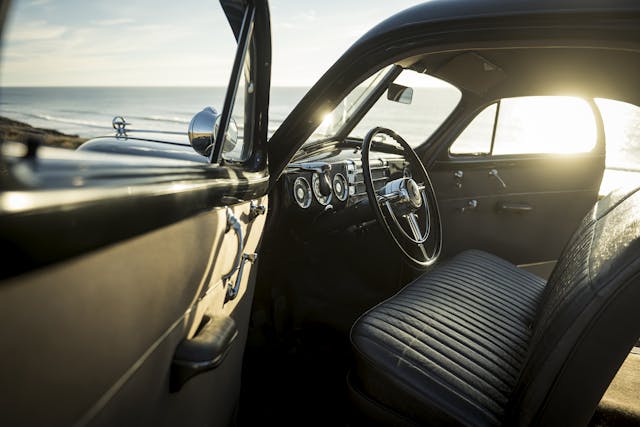
1949 Buick Special Model 46S
Engine: 248-cid I-8
Power: 110 hp @ 3600 rpm
Torque: 206 lb-ft @ 2000 rpm
Weight: 3800 lb
Power-to-weight: 34.5 lb/hp
0–60 mph: 18.4 sec
Price when new: $1790
Hagerty #2-condition value: $20,300–$28,750

1969 Porsche 911E
Engine: 122- cid -6
Power: 140 hp @ 6500 rpm
Torque: 129 lb-ft @ 4500 rpm
Weight: 2250 lb
Power-to-weight: 16.1 lb/hp
0–60 mph: 7.0 sec
Price when new: $6995
Hagerty #2-condition value: $81,500–$104,500

